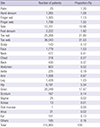1. Havlickova B, Czaika VA, Friedrich M. Epidemiological trends in skin mycoses worldwide. Mycoses. 2008; 51:2–15.
2. Kim HS. The statistical and mycological survey on superficial dermatomycoses. Korean J Dermatol. 1971; 9:1–4.
3. Rhim KJ, Kim JH, Shin S. A clinical and mycological study of superficial dermatophytoses. Korean J Dermatol. 1978; 16:435–442.
4. Min BK, Chung BS, Choi KC, Kim HK. Clinical and mycological studies on dermatophytosis. Korean J Dermatol. 1984; 22:604–609.
5. Lee HK, Seo SJ, Kim MN, Hong CK, Ro BI. A clinical and mycological study of superficial fungal diseases(vii). Korean J Dermatol. 1993; 31:559–566.
6. Moon HJ, Lee JB, Kim SJ, Lee SC, Won YH. Clinical and mycological studies on dermatomycosis (1991-2000). Korean J Med Mycol. 2002; 7:78–85.
7. Lee DK, Moon KC, Koh JK. Clinical and mycological studies on superficial fungal infection. Korean J Med Mycol. 2006; 11:54–63.
8. Lee YW, Yun SJ, Lee JB, Kim SJ, Lee SC, Won YH. Clinical and mycological studies on dermatomycosis (2001-2010). Korean J Med Mycol. 2013; 18:30–38.
9. Kim BS, Suh SB. Mycological and clinical observation on dermatophytosis. Korean J Dermatol. 1976; 14:325–334.
10. Suh SB, Kim SW, Oh SH, Choi SK, Bang YJ. A case of block dot ringworm caused by Trichophyton tonsurans. Korean J Dermatol. 1998; 36:918–923.
11. Sung SY, Kim HY, Kim HU, Ihm CW. Trichophyton tonsurans infection in Wrestlers and a child. Korean J Dermatol. 1998; 36:732–736.
12. Kim JC, Choi JS, Kim KH, Suh SB. Mycological features of Trichophyton verrucosum isolated in Taegu area. Korean J Dermatol. 1992; 30:761–768.
13. Kim YP, Chun IK, Kim SH. A case of kerion celsi caused by Trichophyton verrucosum and its epidemiologic study. Korean J Dermatol. 1986; 24:687–691.
14. Jun JB, Suh SB. Clinical and mycological studies on microsporum gypseum infection. Korean J Dermatol. 1980; 18:369–381.
15. Lee DS, Cho GY, Kim YH, Houh W. A case of tinea capitis due to microsporum gypseum. Korean J Dermatol. 1984; 22:643–646.
16. Lee H, Lee ES, Kang WH, Lee SN. An unusual clinical manifestation of tinea corporis caused by microsporum ferrugineum. Korean J Dermatol. 1987; 25:383–388.
17. Kim HU, Choi CJ, Yun SK. Three cases of tinea capitis caused by microsporum ferrugineum. Korean J Dermatol. 1993; 31:760–764.
18. Kim YA, Lee KH, Lee JB, Suh SB. A case of fungal granuloma caused by Trichophyton violaceum. Korean J Dermatol. 1989; 27:304–307.
19. Lee WJ, Song CH, Lee SJ, Kim do W, Jun JB, Bang YJ. Decreasing prevalence of microsporum canis infection in Korea: through analysis of 944 cases (1993-2009) and review of our previous data (1975-1992). Mycopathologia. 2012; 173:235–239.
20. Lee WJ, Park KH, Kim MS, Lee SJ, Kim DW, Bang YJ, Jun JB. Decreasing incidence of Trichophyton mentagrophytes in Korea: analysis of 6,250 cases during the last 21-year-period (1992-2012). J Korean Med Sci. 2014; 29:272–276.
21. Seebacher C. The change of dermatophyte spectrum in dermatomycoses. Mycoses. 2003; 46:42–46.
22. Seebacher C, Bouchara JP, Mignon B. Updates on the epidemiology of dermatophyte infections. Mycopathologia. 2008; 166:335–352.
23. Aly R. Ecology and epidemiology of dermatophyte infections. J Am Acad Dermatol. 1994; 31:S21–S25.
24. Scher RK, Rich P, Pariser D, Elewski B. The epidemiology, etiology, and pathophysiology of onychomycosis. Semin Cutan Med Surg. 2013; 32:S2–S4.
25. Sigurgeirsson B, Baran R. The prevalence of onychomycosis in the global population - a literature study. J Eur Acad Dermatol Venereol. 2014; 28:1480–1491.
26. Katoh T. Dermatomycosis and environment. Nihon Ishinkin Gakkai Zasshi. 2006; 47:63–67.
27. Ilkit M, Durdu M. Tinea pedis: the etiology and global epidemiology of a common fungal infection. Crit Rev Microbiol. 2014; doi:
10.3109/1040841X.2013.856853.
28. Sei Y. 2006 Epidemiological survey of dermatomycoses in Japan. Med Mycol J. 2012; 53:185–192.
29. Tchernev G, Cardoso JC, Ali MM, Patterson JW. Primary onychomycosis with granulomatous tinea faciei. Braz J Infect Dis. 2010; 14:546–547.
30. Nenoff P, Mügge C, Herrmann J, Keller U. Tinea faciei incognito due to Trichophyton rubrum as a result of autoinoculation from onychomycosis. Mycoses. 2007; 50:20–25.
31. Mirmirani P, Tucker LY. Epidemiologic trends in pediatric tinea capitis: a population-based study from Kaiser Permanente Northern California. J Am Acad Dermatol. 2013; 69:916–921.
32. Monod M, Fratti M, Mignon B, Baudraz-Rosselet F. Dermatophytes transmitted by pets and cattle. Rev Med Suisse. 2014; 10:749–753.
33. Choe YS, Park BC, Lee WJ, Jun JB, Suh SB, Bang YJ. The clinical observation of Trichophyton verrucosum infections during the last 19 years (1986-2004). Korean J Med Mycol. 2006; 11:45–53.
34. Oh SJ, Lee SY, Lee JS. A clinical and mycological study of dermatophytoses in Chungcheongnam-do Province (2008~ 2012). Korean J Med Mycol. 2013; 18:39–47.












